Times critic Giles Coren knew he was in for a treat when he stepped through the door of Juliet in Stroud, Gloucestershire. After all, this modern bistro was the work of “the best man ever to own a restaurant”, artist Dan Chadwick, and sure enough, Coren gave it perfect tens across the board, an accolade he’s only given four or five times in his career. “Everything here,” he wrote, “is all that you dream of when you think of a bistro,” from the “leanest, fruitiest” gazpacho to the perfect hogget steak.
Chadwick already had a glowing reputation locally as the man who breathed life into Laurie Lee’s local, the Woolpack in Slad, turning it into the best restaurant for miles, so he invited sous chef Oliver Gyde to make the 11-minute commute to do the cooking at his new venue. Now you can try making some of Gyde’s dishes at home. Hannah Evans
• Read restaurant reviews and recipes from our food experts
Sardines and sauce vierge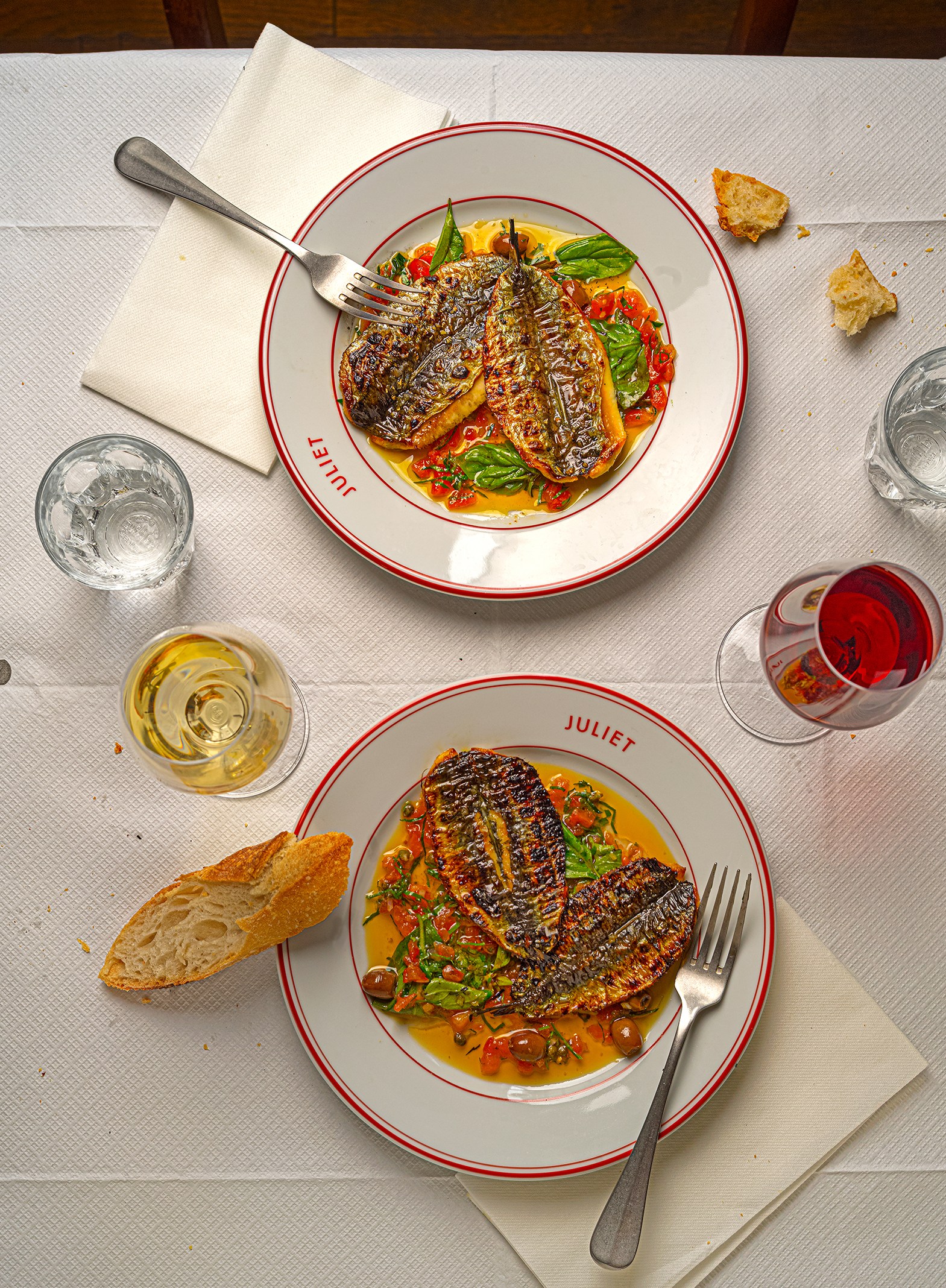
ROMAS FOORD FOR THE TIMES MAGAZINE
Serves 4
We often use sauce vierge on various fish, but when sardines are in season we can’t get enough, especially when cooked on our little grill. The sauce is best served fresh, but will keep for up to two days in the fridge in an airtight container.
Ingredients
• 4 medium ripe tomatoes
• 2 tbsp extra virgin olive oil, plus extra for drizzling
• 2 tbsp small pitted black olives, chopped
• 1 tsp dried oregano
• 1 tbsp flat-leaf parsley, finely chopped
• 1 tbsp chives, sliced
• 1 tbsp capers, rinsed
• 2 salted anchovies, chopped
• 1 small shallot, finely diced
• 1 tbsp white wine vinegar, ideally chardonnay
• 1 tsp coriander seeds, toasted and ground
• Small bunch of fresh basil, leaves picked
• Sea salt and black pepper
• 3-4 sardines per person, whole, guttedor butterflied by your fishmonger
• Lemon juice
Method
1. Score a small “x” on the base of each tomato. Place them in boiling water for 30 seconds, then transfer to iced water. Peel off the skins, deseed and finely dice.
2. Place the diced tomatoes in a mixing bowl. Stir in the extra virgin olive oil, chopped olives, oregano, parsley, chives, capers, anchovies and diced shallot.
3. Add the vinegar, ground toasted coriander seeds and basil. Season generously with salt and black pepper.
4. Mix gently to combine. Taste and adjust the seasoning with more vinegar, salt or pepper if needed. Set aside — it’s best at room temperature.
5. Heat your grill. Lay the sardines skin-side up on an ovenproof tray, drizzle with olive oil and season. Grill for 2-4 minutes until the underside of the fish is cooked through. Finish with a crack of black pepper and a squeeze of lemon.
6. Serve the sardines with the sauce vierge — either sit them on the sauce or drizzle it over the fish — with crusty bread to mop up.
Aubergine caponata
ROMAS FOORD FOR THE TIMES MAGAZINE
Serves 6 as a side dish or 4 as a light main
A perfect and versatile side dish, main or garnish. Store for up to three days in an airtight container in the fridge. The flavours improve after a day.
Ingredients
• Sea salt and black pepper
• 3 medium aubergines, cut into large cubes
• 4 courgettes, sliced into thick rounds
• 3 tbsp olive oil, plus more for frying
• 2 onions, finely diced
• 2 celery sticks, finely diced
• 1 fennel bulb, finely diced
• 3 garlic cloves, finely sliced
• 300g datterini tomatoes
• 3 tbsp moscatel vinegar
• 2 tbsp caster sugar
• 75g green olives, pitted and halved
• 2 tbsp capers, rinsed
• 2 tbsp raisins
• Pine nuts
• Small bunch of fresh basil, leaves picked
Method
1. Liberally salt the aubergine cubes and courgette rounds and leave for 15 minutes to draw out some moisture.
2. Heat a large frying pan over a medium-high heat. Add enough olive oil to cover the base and fry the aubergine cubes in batches until golden brown on all sides. Repeat this process with the courgette rounds. Remove with a slotted spoon and set aside on kitchen roll.
3. In the same pan, adding more oil if needed, sweat the onions, celery and fennel over a medium heat for 10-15 minutes until softened. Add the garlic and cook for 1 minute more.
4. Stir in the tomatoes and cook until they start to soften and burst, releasing the juice to help create a sauce.
5. Add the vinegar and sugar, stirring well. Simmer for 2-3 minutes then taste — there should be a balance of sweet and sharp. Adjust with more vinegar or sugar if needed.
6. Return the aubergines and courgettes to the pan along with the olives, capers, raisins and pine nuts. Simmer for a further couple of minutes, stirring gently so as not to break up the aubergines too much, until everything is coated in the sauce. Season to taste with salt and black pepper.
7. Stir through most of the basil leaves, reserving a few for garnish. Serve warm, at room temperature or chilled, with crusty bread to mop up.
Ribollita (Juliet style)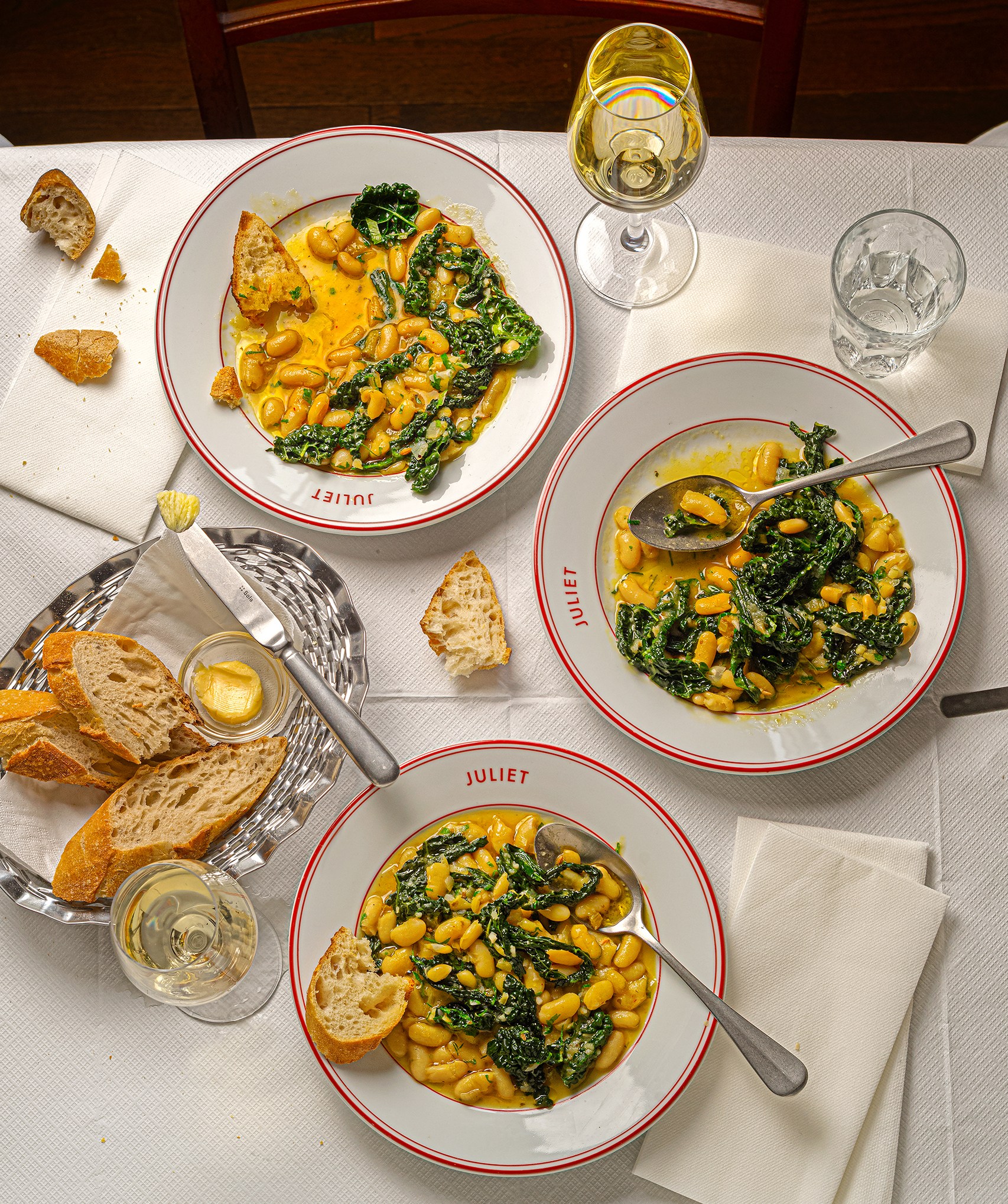
ROMAS FOORD FOR THE TIMES MAGAZINE
Serves 4
This keeps for up to three days in an airtight container Note: we serve the bread on the side rather than stirred into the stew.
Ingredients
• 2 tbsp olive oil, plus extra to finish
• 1 tsp fennel seeds
• ½ tsp chilli flakes
• 4 bay leaves
• 2 onions, finely diced
• 1 fennel bulb, finely diced
• 2 celery sticks, finely diced
• 1 carrot, finely diced
• 2 garlic cloves, finely minced
• 2 glasses dry white wine
• 1 jar cannellini beans, drained and rinsed
• 400ml vegetable stock
• Sea salt and black pepper
• Pinch of fennel pollen (optional)
• 1 cavolo nero, ribs removed, leaves sliced into 1cm strips
• 1 head flat-leaf parsley, finely chopped
Method
1. Heat 2 tbsp olive oil in a heavy-based pan over a medium-low heat. Add the fennel seeds, chilli flakes and bay leaves. Fry gently for about 10 seconds, just until fragrant.
2. Add the onions, fennel, celery, carrot and garlic to the pan. Cook slowly for 30-45 minutes, stirring often, until the vegetables are completely soft with little to no colour.
3. Pour in the white wine and cook until reduced by half.
4. Stir in the cannellini beans and vegetable stock. Bring to a gentle boil, then simmer for 30 minutes until slightly thickened and the flavours are well combined.
5. Season generously with salt and black pepper. Add a pinch of fennel pollen if using. Stir in the cavolo nero and cook for 5 minutes until tender.
6. Mix in the parsley, check the seasoning and ladle into bowls. Finish with a generous drizzle of olive oil. Serve with thick slices of crusty bread for dunking.
Peperonata and pork chops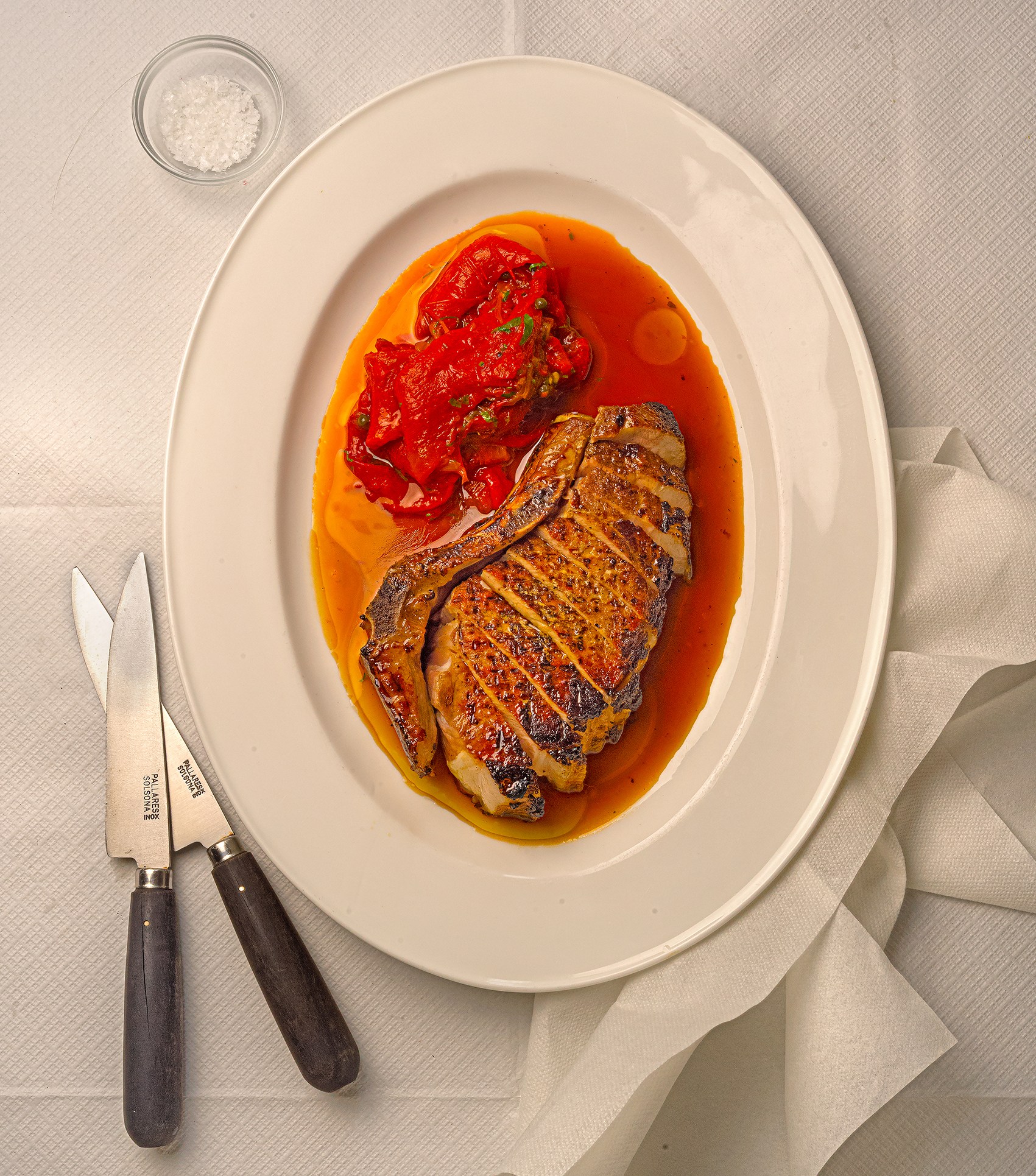
ROMAS FOORD FOR THE TIMES MAGAZINE
Serves 4
We often use peperonata on our menu. It’s great as a garnish for almost all fish and a lot of meats. It keeps for up to three days in an airtight container in the fridge. The flavours improve after a day.
Ingredients
• 3 tbsp olive oil
• 2 onions, finely sliced
• 4 red peppers, whole
• 2 yellow peppers, whole
• Sea salt and black pepper
• 3 garlic cloves, finely sliced
• Half a tin of plum tomatoes
• 2 tbsp moscatel vinegar
• 1 tsp caster sugar
• 1 tbsp capers
• Small bunch of fresh basil, leaves picked
• 2-4 pork chops, depending on size
Method
1. Preheat your oven to 220C fan/gas 9. Heat the olive oil in a large, heavy-based pan over a medium-low heat. Add the sliced onions and cook gently for 15 minutes until soft and translucent, without much colour.
2. Drizzle the peppers with oil, season with salt and pepper and roast them for 5-10 minutes until the skins start to blacken (you could alternatively hold them with tongs over the open flame of a hob if you have a gas stove). Put them in a container for 10 minutes with a lid on to gently steam. Scrape off the charred skin with the edge of a knife, deseed the peppers and cut them into strips. Add them to your onion pan.
3. Stir in the garlic, cook for 1 minute, then add the tinned tomatoes. Simmer gently for 15 minutes.
4. Add the vinegar and sugar, stirring well. Simmer for 2-3 minutes, then taste and adjust the seasoning with more vinegar, sugar, salt or pepper as needed.
5. Stir through the capers and most of the basil, reserving a few leaves for garnish.
6. Pat dry the pork chops and season with salt and pepper. Heat a small splash of olive oil in a frying pan on a medium heat. Add the chops — stand them on their edge just to render down the fat for about 2-4 minutes, until the fat is golden and crisp. Now lay the chops flat and cook for 6 minutes on each side until hot in the centre and cooked through, being careful not to burn yourself with the fat rending out of the pork. Allow them to rest for half the time you cooked them for, then carve and plate.
7. Serve with the peperonata warm or at room temperature, with crusty bread.
Polenta, braised lamb and olives
ROMAS FOORD FOR THE TIMES MAGAZINE
Serves 4-6
If you don’t want to cook lamb, we often use this ragu base with rabbit or guinea fowl. Always olives, though.
Ingredients
• 2kg lamb shoulder
• Sea salt and black pepper
• Olive oil, for frying
• 20 large shallots, sliced lengthways
• 1 head of garlic, sliced
• 3 celery sticks, chopped
• 2 rosemary sprigs, chopped
• 1 tbsp dried oregano
• 1 tsp crushed chillies
• Splash of white wine vinegar, ideally chardonnay
• 200ml white wine
• 1 litre chicken or lamb stock
• 100g small black olives
• 2 tbsp flat-leaf parsley, finely chopped, plus extra to garnish
• 1 packet polenta
• Olive oil, a knob of butter or grated parmesan, to finish (optional)
Method
1. Season the lamb generously with salt and pepper. In a large, heavy-based casserole dish, sear the lamb in a little olive oil over a medium-high heat until browned on all sides. Remove and set aside.
2. In the same pan, add the shallots, garlic and celery. Cook gently for 20 minutes until softened and lightly golden.
3. Add the rosemary, oregano and crushed chillies. Deglaze with a splash of white wine vinegar, then add the white wine and reduce by half.
4. Return the lamb to the pan. Pour in the stock and bring to a gentle simmer. Cover and cook over a low heat (or in a 160C fan/gas 4 oven) for 2½-3 hours, until the lamb is tender and pulls apart easily.
5. Lift out the lamb and leave to cool. Once cooled, strip the meat into long threads. Add back to the sauce and stir in the olives and chopped parsley. Adjust the seasoning with salt and pepper.
6. Cook the polenta according to packet instructions. Finish with a drizzle of olive oil, a knob of butter or grated parmesan, plus wilted greens.
7. Spoon the polenta onto warmed plates. Top with the lamb and its sauce. Garnish with extra parsley and serve.
Ricciarelli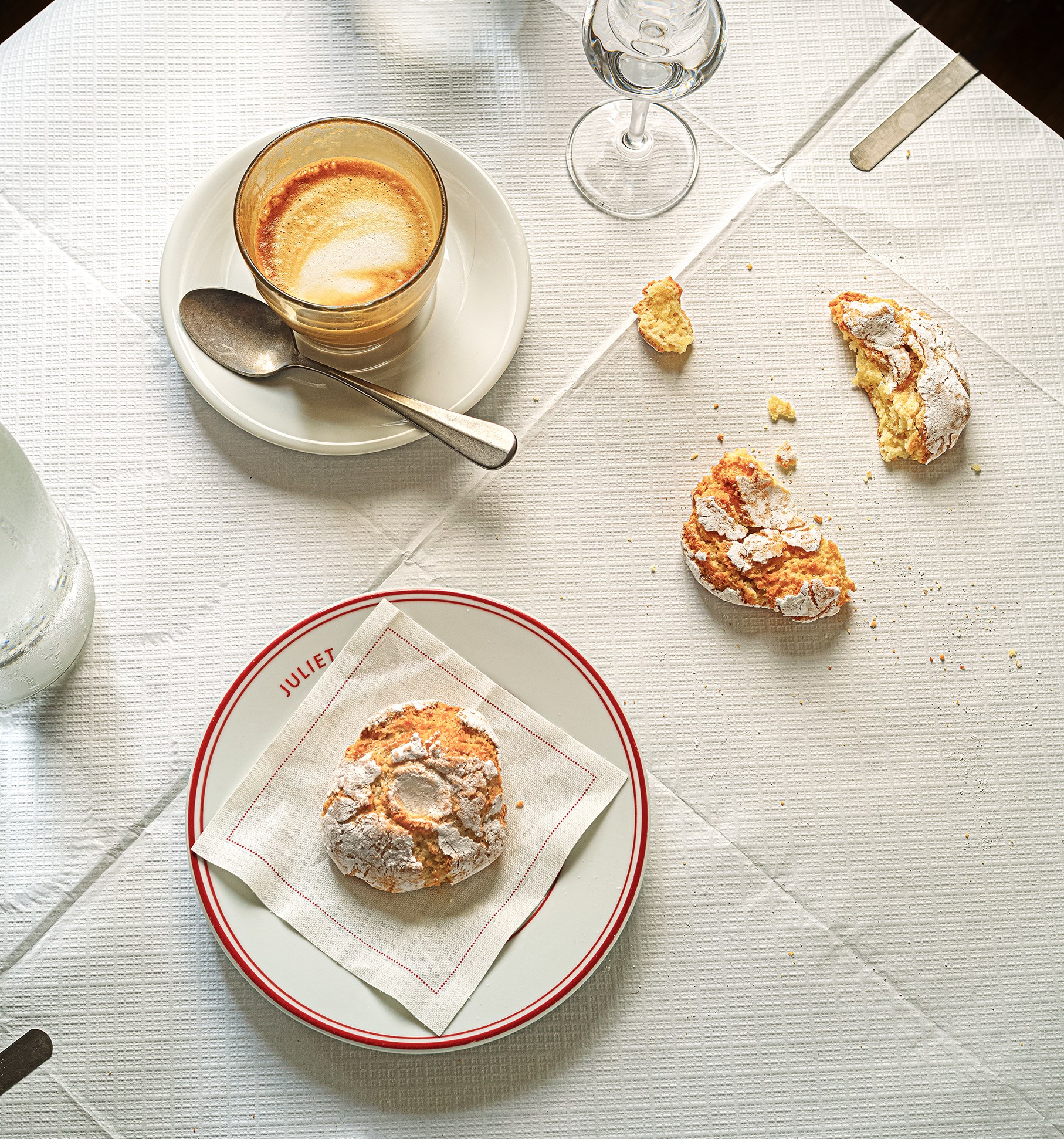
ROMAS FOORD FOR THE TIMES MAGAZINE
Makes 15 biscuits
We serve these in the mornings with coffee — they’re a perfect accompaniment — and on our dessert menus to enjoy with ice cream. If you grease your tray with something other than butter they are dairy and gluten free. They store well for up to three days in an airtight container.
Ingredients
• 10g butter, for greasing, or a non-dairy alternative
• 100g egg whites
• 1 tbsp lemon juice
• 60g icing sugar, plus extra for rolling
• 300g ground almonds
• 275g caster sugar
• Zest of 3 lemons
Method
1. Preheat the oven to 180C fan/gas 6. Grease a large baking tray.
2. Using an electric whisk, beat the egg whites and lemon juice until soft peaks form. Add the icing sugar and whisk to stiff peaks.
3. In a separate bowl, combine the ground almonds, caster sugar and lemon zest.
4. Gently fold the egg white mixture into the dry ingredients until just incorporated. Do not overmix — the dough should feel soft and light.
5. With wet hands, shape the mixture into balls about 35g each.
6. Roll each ball in icing sugar, dust off the excess and arrange on the baking tray about 5cm apart. Lightly press the top of each ball with your thumb and bake in the oven for 12 minutes.
7. Let them cool completely on the tray before serving or storing.
Bay set cream with poached plums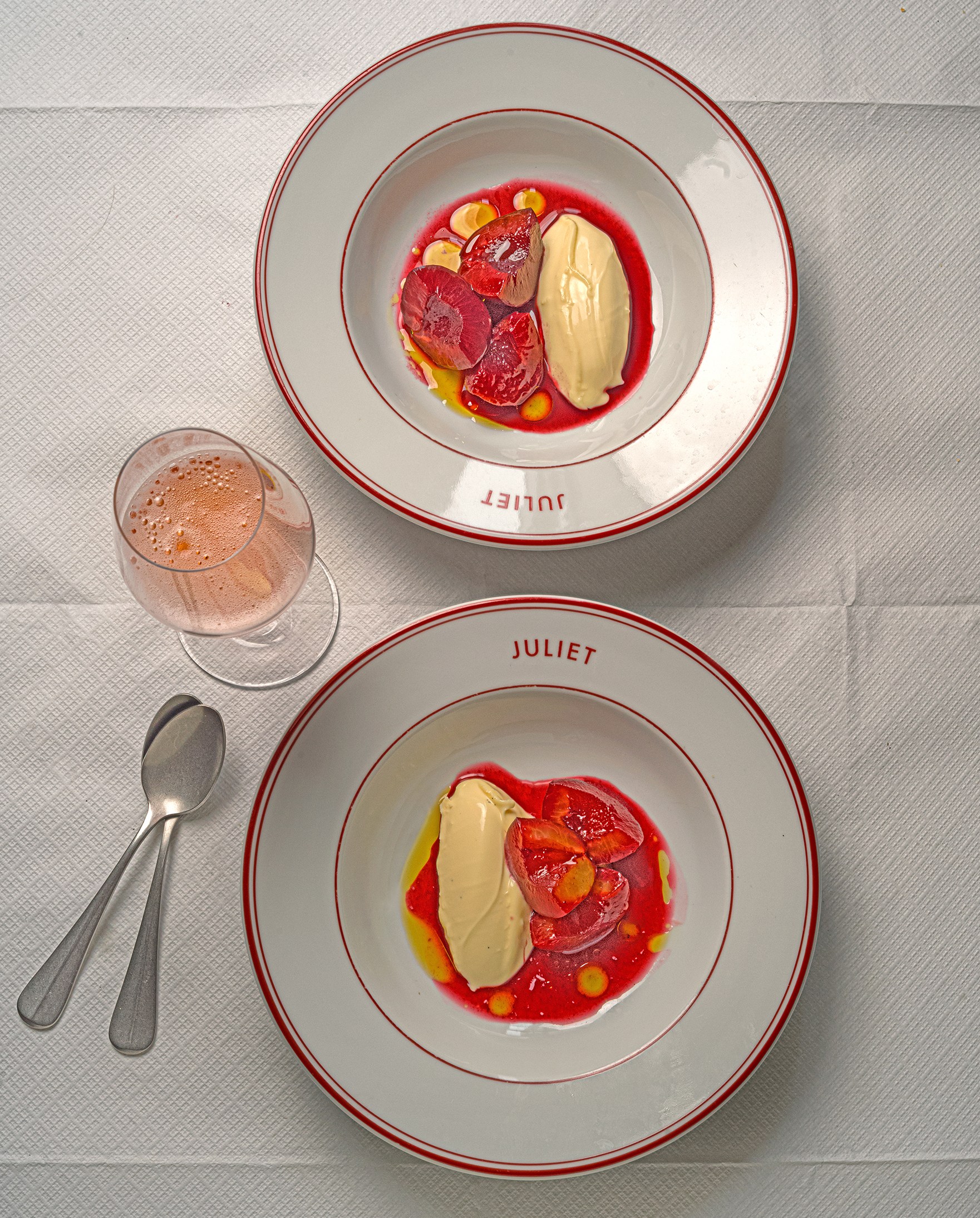
ROMAS FOORD FOR THE TIMES MAGAZINE
Fills 5-10 ramekins, depending on size
The cream will last for up to three days in the fridge, well covered. Add the plums when you are ready to eat.
Ingredients
• 500g double cream
• 200g caster sugar
• 6 bay leaves
• 1 vanilla pod
• 2 bronze leaf gelatine sheets
• 200ml white wine
• Pinch of fennel seeds
• 10 plums, halved and stoned
Method
1. Place the cream, 125g sugar and 5 bay leaves into a saucepan with the vanilla seeds (you will need the pod for later). Bring to a gentle simmer then remove from the heat, cover with a lid and allow to infuse for 30 minutes.
2. Meanwhile, soak the gelatine sheets in ice-cold water until soft.
3. Strain the infused cream through a sieve into a clean bowl. While still warm, stir in the softened gelatine until dissolved.
4. Place the bowl over a larger bowl filled with iced water. Stir occasionally as the mixture cools — the gelatine will begin to set, helping to keep the vanilla seeds from sinking.
5. Pour the mixture into your ramekins and chill in the fridge.
6. Make the poaching liquid: place the wine, remaining 75g sugar, fennel seeds, remaining bay leaf and vanilla pod in a saucepan. Bring gently to the boil, stirring to dissolve the sugar.
7. Remove the pan from the heat. Add the plums to the hot liquid and allow them to cook slowly in the syrup.
8. Once cooled to room temperature (or chilled), serve the plums with their poaching liquid on top of the set creams.
Juliet, 49 London Road, Stroud (julietrestaurant.co.uk; 01453 367019)


Dining and Cooking